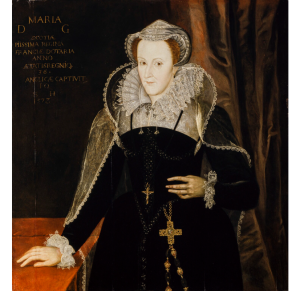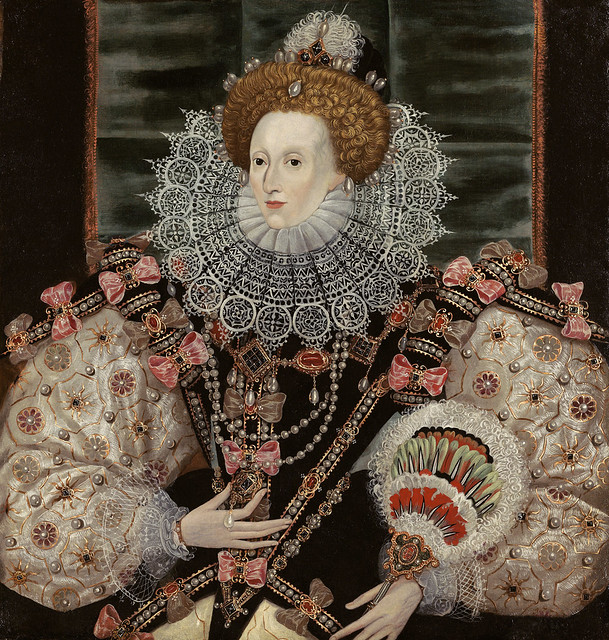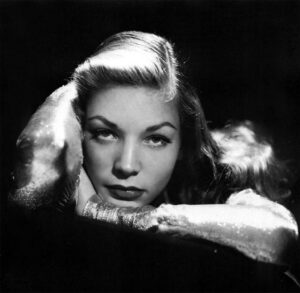
While Queen Elizabeth is often known for being the monarch who presided over the defeat of the Spanish Armada, who defended the Protestant faith, and who was the headstrong virgin queen who refused to marry, perhaps her most controversial encounter was with her own cousin Mary Stuart, Queen of Scots. In Mary Stuart, Elizabeth faced a relentless threat to her crown as well as to her life. Elizabeth and Mary stood on opposite sides of the greatest conflicts of their time: they embodied the growing conflict between Protestants and Catholics, between Tudors and Stuarts, and between that most ancient of rivalries, the English and the Scottish. These two monarchs’ conflicts lasted from 1561 to 1587 and ended in one final and fatal decision. Yet, despite nearly three decades of obsession with one another, the two women would never actually meet. Their explosive relationship played out entirely through letters written with a mirrored intimate passion that burned through Elizabeth and Mary behind scatterings of ink and elegant phrases. Their correspondence swirled with a dark, deadly current that went on to drag one of the writers down.1
It was unclear whether the kind poetic words on sisterhood and friendship were genuine between the two queens, but one thing is for sure. As long as Mary was still alive, Elizabeth’s claim to the English throne would always be in danger. It didn’t help that at the start of her career, Mary had a legitimate claim to succeed to the throne of England after Elizabeth. Mary asked Elizabeth to confirm her as successor, but Elizabeth wisely, one would think, decided that this would not be a good idea. Instead, she stated: “If it became certainly known in the world who should succeed me, I would never think myself insufficient security.”2

With tension between the English Catholics and Protestants surging, there was a fear that just Mary’s presence would be enough to inflame English Catholics to support her claim. English Catholics had a settled hatred for Elizabeth’s mother, Anne Boleyn, for being one of the reasons for England becoming Protestant. Henry VIII assumed leadership of the Catholic Church in England in order to go through with his marriage to Anne Boleyn. This did not leave Elizabeth as a very beloved queen in the eyes of the English Catholics. Elizabeth was seen as a bastardized successor, and Mary, being the good Catholic that she was, would have the support of English Catholics if she tried to seize the throne.3
This threat became the obsession of Elizabeth’s chief minister, Lord Burleigh. Burleigh was constantly dripping poison into Elizabeth’s ear about Mary. With this concern, Elizabeth never gave Mary a clear answer as to making Mary her successor. Through years of charm and kind letters, Mary hoped to win over Elizabeth, but she was not successful in her endeavors. Following the death of her husband Francis II of France, Mary looked for a new husband, one that would support her claim to the English crown. Elizabeth offered a suitor for Mary, Robert Dudley. Elizabeth had great trust in Lord Dudley; she knew if wed to Mary, he would not let her seize the throne, and he was in no high authority to support any claim as king. Mary was insulted by this offer and decided to go without Elizabeth’s blessing to marry Elizabeth’s half-cousin, Lord Darnley. He later turned out to be a not-so-perfect husband, and Mary quickly found herself in misery. Looking for a way out of her misery she looked for another husband and was later accused of conspiring with Lord Bothwell to murder her current husband, who died in a mysterious explosion at his home. She then wed Lord Bothwell and this left Scotland in the chaos that brought much glee to Lord Burleigh. However, Elizabeth put her support behind Mary, perhaps sympathizing with Mary and her scandals with men. After all, Elizabeth’s mother was beheaded by her father, and she was constantly physically abused by Thomas Seymour. Elizabeth, against all odds, did not want to be the cause of the demise of an anointed queen. Elizabeth declared war on the Scottish Lords who dared hurt or touch Mary. Instead, the Lords placed her in a prison and forced her to abdicate. Having no other choice, Mary agreed and looked to Elizabeth for refuge. Instead of a royal welcome, Mary ran straight into a trap by Burleigh. He immediately had her locked up. From the moment Mary set foot in England, he wanted her dead.4

Lord Burleigh needed evidence to sentence Mary to her fate, so he intercepted encrypted letters from Mary’s Catholic supporters, which showed that they were plotting to put her on the throne. Mary now became a real threat, whether or not she was trying to get Elizabeth’s throne. Other people were constantly trying to put Mary on it. Mary denied having any part in such conspiracies. To add to the already boiling tension between Elizabeth and Mary, the two queens were caught up in a battle much bigger than themselves. Catholics and Protestants were dying on both sides and what happened between Elizabeth and Mary had become polarized as figureheads on two sides of this battle. To Lord Burleigh, the Catholics were a danger to Elizabeth’s throne, and he continued to whisper into Elizabeth’s ear that there would always be a threat so long as Mary lives. Elizabeth did not give in, as her honor and conscience forbid her to do so. Mary was placed in various castles all over England, but never accepted being a prisoner. Months turn into years for Mary, and Mary never grew tired of writing to Elizabeth, asking for her freedom and to meet with her. Elizabeth simply stonewalled any line of communication that Mary attempted to create.5
Elizabeth had the bright idea that Mary might go back to Scotland and rule jointly with James, but James decided to ditch his mother and did not negotiate for Mary’s freedom to return to Scotland. With this loss of hope of regaining her crown and of convincing Elizabeth to help, Mary became obsessed with gaining Elizabeth’s crown. Eventually, Lord Burleigh suspected that Mary was plotting to kill Elizabeth and sent his spies to get proof. Mary became a public figure for young male Catholics who wanted to give their lives for their faith. It didn’t take long for a young Catholic, Anthony Babington, to write to Mary and approach Burleigh’s trap. Babington wrote to her and said that he would help spring her from her imprisonment, and at the same time, six gentlemen would do the deed and assassinate Elizabeth. Babington and Burleigh were waiting for Mary’s reply, and when it arrived twelve days later, Mary basically damned herself in the letter. Burleigh’s spies brought him the letter, and he, in turn, brought it to Elizabeth. Any sympathy Elizabeth had for Mary quickly evaporated. Elizabeth was enraged with Mary and her accomplices, and couldn’t believe that they would betray her after she had saved her life countless times. Despite the proof, Elizabeth couldn’t bring herself to condemn Mary. She felt terrified that God might judge her for putting to death a ruler with a divine right to rule. Instead, she turned her rage on the young plotters in a cruel and gruesome way.6

On October 25, 1586, Mary was pronounced guilty of conspiring to murder Elizabeth. Even then, Elizabeth wouldn’t do anything. She just wanted it all to go away, as she didn’t want to be the source of the execution of an anointed Queen. She knew that Mary had to die, but when it came to it, she couldn’t quite bring herself to believe that she was the person who was striking Mary’s head off. To push her to make this decision, she was told by Burleigh that the Spanish Armada was set to invade Wales. Burley invented a full-scale invasion to push her into signing off on Mary’s execution. She called for the warrant and Elizabeth signed it after they had been pressuring her into doing it. Suddenly, it was done, and Burley quickly sent for the executioners, but then almost immediately Elizabeth acted as if she didn’t know what she was signing. She was given a pile of papers by her secretary, who should have told her that at the top of the pile was a warrant for the execution of Mary, Queen of Scot. Elizabeth blamed everyone else but herself. After nineteen years of confinement under Elizabeth’s orders, Mary was sentenced to death on February 8, 1587. 7
We will never be sure what Elizabeth really felt for her cousin, but Mary’s execution marked her forever. This event was something Elizabeth never really got over: she always denied that she’d been responsible for Mary’s death, and even lied point-blank to James, Mary’s son and King of Scotland, that she was responsible. After twenty-six years of never having met, Mary and Elizabeth now found themselves bound together forever in a controversial episode in history. Who won the battle? It may seem that the winner is obvious, as it was Elizabeth who put to death Mary, Queen of Scots, and thus vanquished her rival in the end. But arguably Mary had the last laugh because it was her son James who would become King of England upon Elizabeth’s death. Without any children of her own and without anyone else to leave the throne to, she was forced to leave the throne to the son of her greatest rival. Mary’s son James not only went on to rule both Scotland and England, but he ensured that every subsequent British monarch would carry the blood of Mary, Queen of Scots. Mary has shaped history as profoundly as she had affected Elizabeth. Elizabeth was haunted by Mary’s ghost for the rest of her days. She could never quite get out of her head the guilt that she felt for putting Mary to death. 8
- David Starkey, Elizabeth: The Struggle for the Throne (New York: Harper Perennial, 2007), 56. ↵
- Agnes Strickland, The Life of Queen Elizabeth (London: J.M. Dent & Sons Ltd, 1924), 31. ↵
- G. W. Bernard, Anne Boleyn : Fatal Attractions (NH: Yale University Press, 2010), 62. ↵
- James Fitzmaurice, Naomi J. Miller, and Sara Steen, Authorizing Early Modern European Women: From Biography to Biofiction. (AMS: Amsterdam University Press, 2021), 101-114. ↵
- Henry Sidney and Arthur Collins, Letters And Memorials Of State In The Reigns Of Queen Mary, Queen Elizabeth, King James, King Charles the First, part of the reign of King Charles the Second, and Oliver’s usurpation (London: T. Osborne, 1746), 32. ↵
- Neil Younger, “Robert Peake (C1551—1619) and the Babington Plot,” The British Art Journal 14, no. 2 (2013): 63. ↵
- Neil Younger, “Robert Peake (C1551—1619) and the Babington Plot,” The British Art Journal 14, no. 2 (2013): 65–67. ↵
- Larissa J. Taylor-Smither, “Elizabeth I: A Psychological Profile,” The Sixteenth Century Journal 15, no. 1 (1984): 47-72. ↵



23 comments
Jesslyn Schumann
This was a very well written article. It felt like the more you read, the more you were drawn in to the family drama that was present between the Queens. I had known there was some drama between the two sides, but not this much. It makes you look at both sides quite differently, which is wonderful! Good luck with the award ceremony and thank you again for such a wonderful read!
Elizabeth Hernandez
The way you wrote the story of the rivalry between Queen Mary and Queen Elizabeth was intoxicating. Your prose is incredible, and brought some life to a story about death. I recently read a novel (fiction) that took place in the midst of this chaos between the Catholics and English Protestants, and knowing this part of the story deeply aided my understanding of the novel.
Justine Ruiz
This was hands down one of the most amazing articles I have read yet! The way you wrote this story unfolding in a way that was addicting and extremely intriguing. It was interesting to learn that both women had never met yet had such a strong connection. I would love to have learned what those letters told, but that will remain a mystery to the world. I did not agree with the fact that Queen Elizabeth never owned up to the death of Mary.
Vianne Beltran
Hi Giselle,
Elizabeth I is one of my favorite historical figures to learn about and I’ve read a lot about her over the years. Your article did an excellent job at describing the complexity of her reign. I always thought that Mary must have been very desperate if she turned to Elizabeth for safe haven. I think it’s interesting that Elizabeth thought she could not be guilty of her cousin’s death if she simply ignored her existence.
Mckenzie Gritton
Great article! I love reading about Queen Elizabeth and Mary Queen of Scots. Both of these women were so ambitious. What I would give to be able to read their correspondences. I had also not known that they were eventually friends, I was under the impression that they hated each other till their dying day. It is sad though that Elizabeth never admitted to having a hand in Marys death.
Dhwani Chandi
As I read the title for this article it attracted me because it felt very fancy drama and controversial at the same time also a big thing is that this is not a part of any movie or series it is actually real. the line in the paragraph about Elizabeth’s mother being beheaded by her father made me think for a while that what she must have gone through and sometimes how harsh could be the historic times. As I said earlier it was a controversial yet interesting article and must have left an impact on every reader. Congratulations on your nomination!
Mauricio Rebaza Figueroa
Hi Gisselle. Congratulations on the publication of your article! It is such a well elaborated article and it helped me understand way more about the history of Queen Elizabeth, history I barely knew nothing about before reading your article. It is rich on information and your use of sources was very well done. The images you used are also quite helpful when understanding what am I reading about. Overall, a really good article, good job.
Paula Ferradas Hiraoka
Hello Giselle,
First of all, congratulations on your nomination and getting your article published!
Your article is pretty well-written and the pictures you choose are amazing and mix perfectly with the story itself.
I greatly enjoyed your introduction in establishing the well-known perception of Elizabeth I, but at the same time I’m impressed of having a battle with herself for quite a long time. Another thing that really impressed me is her relationship with her cousin Mary, Queen of Scots, that you decided to explore in your article.
Overall, what an amazing article and good luck!
Claire Saldana
I am in shock that Elizabeth had this internal battle with herself for so long yet still went through with it. She knew she did not have the right to kill Mary and that everything she was told was either false or exaggerated. However, I love that mary’s son took over, and now Elizabeth has no representation in the thrown anymore. It’s sad that she fell into the temptation but in the end, she got what she deserved.
Madison Goza
I loved your use of images throughout the article; the portraits during this time were spectacular! I also greatly enjoyed your introduction in establishing the well-known perception of Elizabeth I and then offering a new face to that perception, her relationship with her cousin Mary, Queen of Scots, that you explore in your article. Beautiful writing, excellent research, and a job well-done!